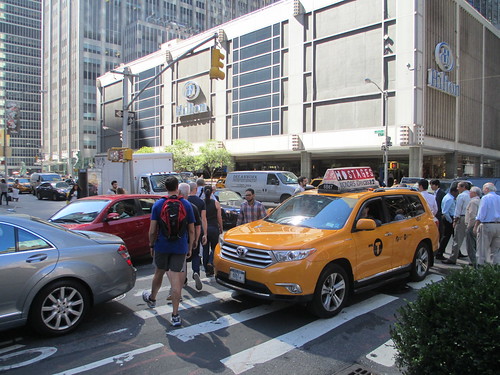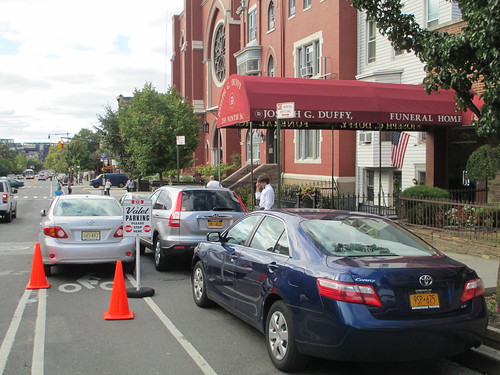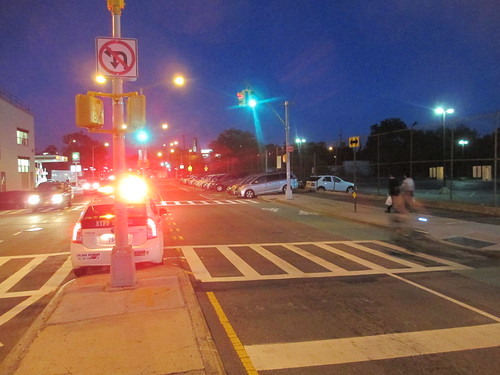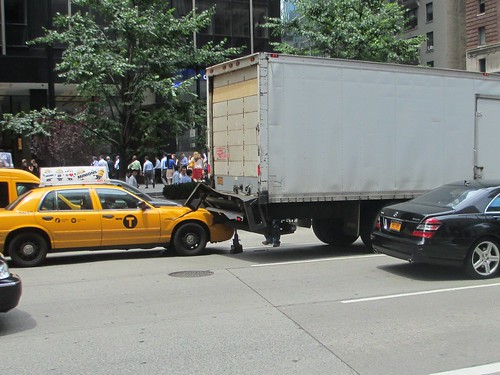It put the injury I’d sustained in a whole new light. My
neighbour looked down at my foot as we stood in the elevator and gave me a
pitying look.
“Yes, it’s easier to do that kind of thing as you get
older,” he said. “And it starts to take longer to heal.”
It was the first that I’d thought of the misfortune of the
broken bone in my foot as anything other than simple bad luck. I broke it, I
think, in April and limped around all May in varying degrees of pain. Since the
injury was finally diagnosed on June 3, I’ve been lumbering around in an
orthopaedic boot, desperately hoping for the injury to heal.
 |
| My favourite conveyance, next to one I dislike intensely: my bike and my orthopaedic boot |
But the moment I thought of my misfortune as a kind of
memento mori – a portent of my steady progress away from birth and closer to
death – I couldn’t unthink it. My injury made me, I realised, temporarily a
person far older than my 44 years. It’s made me realise how apt my fellow New
Yorkers – and I myself – am to judge someone by a superficial change to their
appearance such as the sprouting of an ungainly plastic boot. It’s an insight
that I hope to retain after the blessed day when the boot comes off and my bike
once again leaves its resting place by the living room closet.
But I’d still far rather none of the sorry mess had
happened.
It started with a dull pain I noticed in my left foot while
cycling. It hurt when I put the foot down during stops at traffic lights. I
assumed that, like most such aches and pains, it’d get better. Then, on the
visit to Michigan
that I mentioned in a previous blogpost, I walked around, putting weight on it,
and found myself hobbling in agony. That pain was alleviated only when I
returned to New York ,
resumed cycling and found the pain receded to a minor irritant. Then I went on
a second cycle-less trip, to Colorado ,
resumed my agonised hobbling and realised I’d need to get it properly checked
out.
The second doctor I saw worked out what was wrong.
“You’re broken clean through there,” he said, pointing on my
x-ray to a bone that I now know to be the proximal phalanx in the fourth toe on
my left foot. His colleague ten days before had pronounced the x-ray “normal”.
 |
| Is that car stopping or going? It's a question that's grown more stressful for me lately. |
The doctor produced an intimidating-looking boot and, over
my protests that I’d cycled to the appointment, told me I’d be wearing it for
at least two weeks.
It transformed my sense of myself. Now I was unable to do
it, I realised how light and easy cycling feels to me. I feel much of the time
as if I’m skipping round town on my bike. I suddenly felt slow, lumbering and
foolish. I didn’t even have a heroic story. I don’t know for sure – beyond
thinking I might have carelessly kicked a kitchen chair in bare feet – how I
broke it.
That was before I even tried crossing the street.
When I approached crosswalks, I found all the things I
normally took for granted – the ability to get across quickly, a confidence in
facing down cars, an ability to take evasive action – had diminished. My stress
levels rose in ways they never normally did over decisions about whether to
cross when the right countdown clock showed, say, 10 seconds.
Even worse, I found some motorists seemed not only less solicitous
than normal but actually less patient. When moving more slowly, I seemed to
represent a greater possible obstacle. I became someone motorists were even
keener than normal to have out of their way.
On the subway, my boot seems to be invisible when I'm standing and need a seat, but to become hyper-visible if I'm delaying someone on the stairs.
I in turn have found myself growing still crankier than normal. The air sacs in the boot I was given turn out to be prone to puncturing. With the air sacs deflated, the boot rubs painfully against my ankle. The pain is like chilli powder rubbed into the open sore of my bad mood over needing the boot in the first place. The only comfort is that I finally hit on the solution. I’ve put a bike inner tube inside the boot and now use it to keep the boot comfortable.
The most shocking street-crossing incident came as I walked my son to school one morning, him on his bike and me hobbling on my orthopaedic boot. At a crosswalk near his school, I waved and shouted in frustration at a van whose driver barged through the crosswalk as we tried to cross. That served to irritate a driver behind, who lent out as I crossed to shout at me, “Why were you shouting?” When I stopped and turned round to answer him, he drove his car towards me to get me to move.
I in turn have found myself growing still crankier than normal. The air sacs in the boot I was given turn out to be prone to puncturing. With the air sacs deflated, the boot rubs painfully against my ankle. The pain is like chilli powder rubbed into the open sore of my bad mood over needing the boot in the first place. The only comfort is that I finally hit on the solution. I’ve put a bike inner tube inside the boot and now use it to keep the boot comfortable.
The most shocking street-crossing incident came as I walked my son to school one morning, him on his bike and me hobbling on my orthopaedic boot. At a crosswalk near his school, I waved and shouted in frustration at a van whose driver barged through the crosswalk as we tried to cross. That served to irritate a driver behind, who lent out as I crossed to shout at me, “Why were you shouting?” When I stopped and turned round to answer him, he drove his car towards me to get me to move.
The crosswalk run-in chimed with something I’d heard from an older
neighbour who cycles but is currently injured after a fall from his bike. He’d
been impressed one time recently, he said, when a motorist had been unusually
tolerant in letting him cross a crosswalk. But the driver then lent out of his
car and shouted, “Walk faster!”
There’s a malice about both incidents that goes well beyond
New Yorkers’ focus on those using their own means of transport or an understandable desire to get about as fast as they can in a city
that often doesn’t facilitate it. It topples over at times into a bullying impatience with the weaker based on what seems like contempt for their weakened
state. It’s something that I imagine less mobile people in other big cities
also experience. But I have a feeling it might be especially acute in New York City , a dark
negative to the city’s remarkable, positive get-up-and-go energy.
The two-week minimum period the doctor prescribed for me in
the boot concludes on Tuesday. I’m already picturing myself, if a new x-ray is
clear, ditching my orthopaedic boot, rushing home and heading into the city on my bike. I will, I’m sure, feel a new appreciation for the privileges of being
able to cycle in one of the world’s greatest cities, taking in the view each
morning from the Manhattan
Bridge Allen St .
I’m planning to be more solicitous once I’m free, however,
of the needs of people who can’t get about as easily. I won’t be on the subway
as much in future – but, when I am, I want to be one of the people who’s given
me a seat, rather than one of the masses of people who’ve sat and watched me
balance on my boot. I’m acutely conscious of how the boot seems to have changed
how people react to me, without there having been any significant change in my
personality.
In the hurly-burly of the city, I probably won’t live up to
my intentions all the time.
But I should bear in mind my neighbour’s remark in the
elevator. I’m fortunate that, for the moment, being less mobile is only a
temporary state for me. Yet, barring some
unforeseen catastrophe, I’ll one day be so much older that the effects are obvious all
the time. I want to fix in my mind how, when I’m impatient of older
pedestrians’ slow walk across a crosswalk or down a street, I’m demonstrating a
bullying callousness I don’t want people to show the older me.











